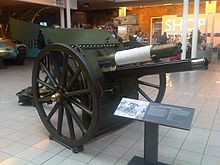1st Forfarshire Artillery Volunteers
[22][23][26] During the winter of 1914–15 the division's 1st Line units underwent war training, and a number left to join the British Expeditionary Force (BEF) on the Western Front.
(R (H) Battery had originally been C (H) Bty of CLI (1st County Palatine) Bde of 30th Division, a 'Kitchener's Army' unit raised by the Earl of Derby in Lancashire in 1914.)
A quarter of the 18-pounders deliberately fired 100 yards (91 m) short of the barrage line – this would have suppressed German outposts sheltering in shell craters in No man's land.
The brigade then had the following organisation for the rest of the war:[22][24][25] For the Battle of Arras opening on 9 April, the biggest concentration of guns yet seen was assembled, all working to a single plan.
Overall, XVII Corps' attack was a great success, even though some of 51st Highland's men were held up by unsubdued machine guns and drifted away from their barrage.
Dyson, personally went forward to reconnoitre the confused situation on the division's front, finding that the objective of Point de Jour was only partially held.
Gains had been made, but now the rain came, and the guns had to move up through shell-churned mud to fresh positions before the attack could be renewed, and continued to suffer badly from German CB fire.
[41][42] 51st (Highland) Division was then moved south to take part in Third Army's surprise attack with tanks against the Hindenburg Line at Cambrai on 20 November.
There was no preliminary bombardment, but for the attack the divisional artillery was reinforced, firing a lifting barrage of smoke, high explosive (HE) and shrapnel shells.
The initial attack was a brilliant success, but on 51st (H) Division's front the advance stalled once the tanks crossed the Flesquières ridge, where many were knocked out by unsuppressed enemy guns.
Air photos revealed signs of these preparations on 51st (H) Division's front, including numerous rectangular mounds in the valley of the River Agache that the staff dubbed 'lice'.
Each RFA brigade (CCLVI was supporting 153rd (2nd Highland) Bde on the division's left) deployed nine 18-pdrs and four 4.5s forward, with the remainder of the guns in the main battery positions 3,500 yards (3,200 m) back.
In addition 51st Divisional Artillery deployed seven single 18-pdrs and two old 15-pdrs as anti-tank guns in the support and reserve line where they could cover the main approaches over open sights.
Most of CCLVI Bde's forward and anti-tank guns had been destroyed by shellfire, but as the mist began to clear the survivors took a heavy toll of the German infantry.
Attempting to widen the hole in the flank, large numbers of Germans were seen at 2,000 yards (1,800 m) range: all four of CCLVI Bde's batteries hauled their guns out of their pits, swung them round, and engaged the enemy over open sights, inflicting such heavy casualties that further progress was checked for a time.
On 25 March 51st (H) Division was presented with some remarkable targets of German masses at long range, which were prevented from closing, but the enemy continued to move round the flank.
The divisional artillery arrived on the evening of 9 April, just after the second phase of the German offensive (Operation Georgette) had struck First Army (the Battle of the Lys).
In fact, the Germans withdrew across the Marne, and when the division attacked again the following morning the information on enemy positions was so poor that the barrage was fired too far ahead to be of use.
It left Aldershot and landed at Le Havre on 31 January to join the new British Expeditionary Force (BEF), deploying at Avelin near Lille.
The Wehrmacht's Army Group B had been ordered to break through quickly between Louvain and Namur, but the artillery concentrations caused the leading troops to draw back.
It was a difficult night move along roads packed with refugees and under bombing, but at dawn the regiment deployed in good positions in support of 9th Bde on the River Dendre.
Other parties got away from La Panne[ in small boats but sustained casualties after they had transferred to the Isle of Wight ferry Gracie Fields when she was sunk 40 minutes after sailing for England.
Of the 18 LCTs taking in 3rd Division's three SP field regiments, six were damaged by enemy fire, five by beach obstacles and three by mines; two of these were total wrecks.
[88][112][113] 3rd Division then held the line of the Rhine while the rest of XXX Corps pulled back to organise and train for the assault crossing Operation Plunder.
[88][114][115][116][117] 3rd Division later crossed the Rhine and took part in the advance across North Germany, capturing Lingen and cutting the Bremen–Delmenhorst road en route to the city of Bremen, which fell after five days' stiff fighting on 27 April.
It achieved a bridgehead but further advance was checked, so on the night of 20/21 July the division sent a composite force of infantry and armour against the main enemy defences at Gerbini Airfield, supported by 127th Fd Rgt and other artillery.
It was mainly engaged in Defensive Fire (DF) tasks: several German counter-attacks were broken up by shellfire, but the regiment's own casualties mounted steadily.
[155][156] The division's next offensive action was west of 's-Hertogenbosch on the night of 23 October, when 300 guns were used and the infantry took all their objectives, with follow-up advances over succeeding days through Loon op Zand and across the Afwaterings Canal towards the Meuse (Dutch: Maas) by early November.
Captain Swaab acting as FOO brought down fire on Germans retreating along the Meuse (Dutch: Maas) bank from 1st Battalion Gordon Highlanders.
[174][175][176][177] The regiment began occupation duties at Bevern, Lower Saxony, moving to Verden in June, and handed in its guns at the end of July.












